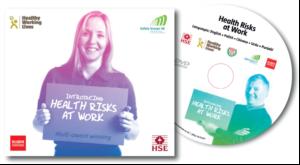Do you know your health risks at work? The mission of a campaign,
promoted by Safety Groups UK and Healthy Working Lives, is to ensure
that the answer is 'yes', explains John Cairns and Robert Atkinson
Do you know your health risks at work? The mission of a campaign,
promoted by Safety Groups UK and Healthy Working Lives, is to ensure
that the answer is 'yes', explains John Cairns and Robert Atkinson
Health risks at work - do you
know yours? This is the major
question being posed by
Scottish Safety Groups facilitated by
SCoS (Scottish Chamber of Safety) and
supported by SCHWL (Scottish Centre
for Healthy Working Lives), HSE,
RoSPA as well as the general Scottish
safety community at Health and Safety
Scotland.
It's a fair question, as all employers -
particularly SME's - are required to be
aware of the risks that personnel are
exposed to during their work activities and
understand the steps needed to address
these exposures. Safety is regularly referred
to as 'health and safety' but for most
organisations the knowledge in this area
has extended only into safety. Thus we
have developed the silent 'health' in health
and safety, and the term as a whole has
been used widely to mean you can't do
something. As a result, the real focus of
health and safety within a business, that
being to ensure that the work gets done
and the activities and final products are safe
and without risk to employees and users
alike, is often lost. Health and safety at
work should add value to the
organisation, after all, the only place to
have a cost effective employee, is at work.
Demonstrating the effect of a fall from
height or vehicle accident is visual and
immediately apparent, but it is more
difficult for managers to get messages about
protecting health, over to staff when there is
no visible effect, at least in the short term.
Things are changing, health is coming
to the fore and increasingly organisations
are identifying that maintaining a healthy
workforce has economic benefit,
especially in a time of economic difficulty
and where projections point to an ageing
workforce being required to work longer
before retirement.
So, are you aware of the exposures to
chemicals, dusts, poor posture, noise,
vibration and stress levels among your
workforce? Are you aware of the harm that
this causes to their health, sometimes in the
short term but more realistically in the
medium-to-long term? Are you aware that
failure to identify and manage these
exposures can have impacts on your
organisation in terms of costs through staff
illness, early retirement, potential legal costs
and loss of skilled and experienced
workers? Managing staff health can help
you mitigate against these potential losses
and it's perfectly realistic to need help and
support to identify, manage and educate
staff on these risks.
Health Risks At Work Initiative There are plenty of opportunities to
address health issues at work and the
focus of a current initiative promoted by
Safety Groups UK and Healthy Working
Lives looks at health conditions caused or
made worse by work exposures and
activities, and offers businesses free
support and tools to address the issues
and videos to help get the messages over
to employees in a quick and efficient way.
The initiative, called Health Risks at
Work began life in Scotland and has
become a national campaign
communicating in clear language to raise
awareness of risks to breathing, skin,
muscles, bones and joints, hearing and
touch, and wellbeing. The resources of the
initiative are available free to all businesses
looking for support and SME's in Scotland
can access free face-to-face support and
hard copies of the materials.
So how does it work? You can log onto
www.healthrisksatwork.com and view the
introductory video in English, Polish,
Chinese, Urdu and Punjabi. This and the
other videos (three minutes each) are an
ideal way of introducing your staff to the
topics and can be used in meetings,
training or during tool box talks to
introduce a specific topic area. There are
then five key chapters on common workrelated
health risks and where possible the
health and safety jargon has been
removed. There is also a chapter on how
and where to get help and support locally.
The principle of the tool kits is to
encourage employers to help themselves:
each chapter asks and answers a series of
questions which can be translated into
each workplace's work practices and
activities. This aims to demystify the
process of risk assessment and help
businesses decide on what prevention and
control measures need to be implemented
to reduce work-related ill health in their
specific conditions.
A free DVD entitled: "Introducing
Health Risks at Work" will be provided to
those who attend the presentations on
Health Risks at Work in the Safety
Dialogue area at Health & Safety Scotland.
Health Risks at Work also covers the main
requirements of the health component of
the Estates Excellence project which is
currently being rolled out across the UK.
Further help and support is available from
Healthy Working Lives at
www.safetygroupsuk.org.uk/
topics/health_risks_at_work.htm and from
www.healthrisksatwork.com
Visit Safety Groups UK on Stand 21.
John Cairns is vice chairman, Safety
Groups UK. Robert Atkinson is OHS
development manager, Healthy Working
Lives


